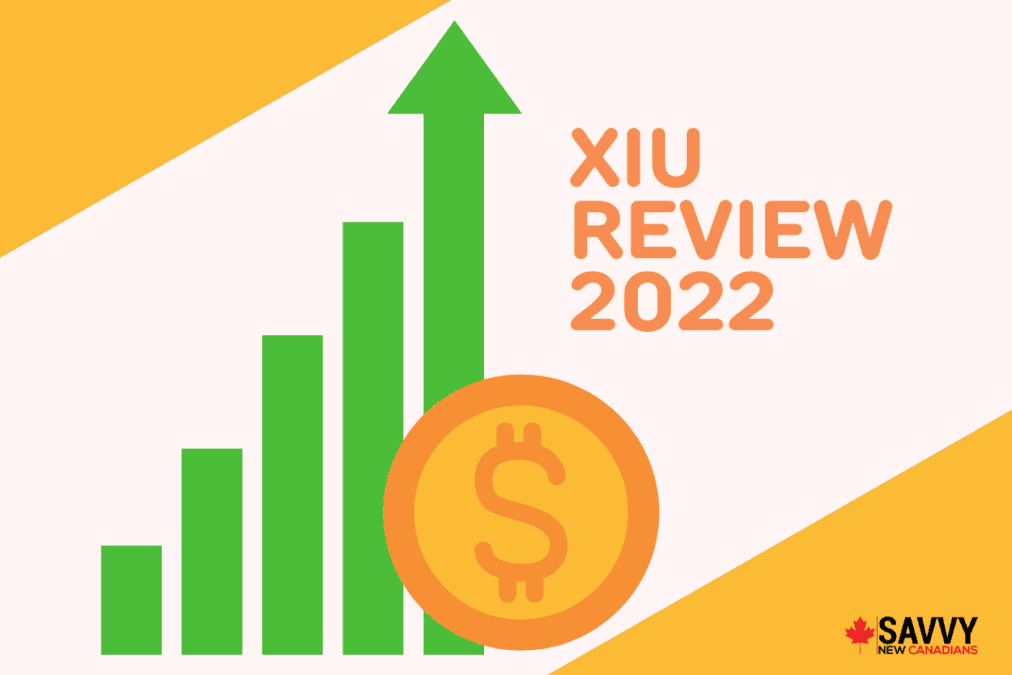The iShares S&P/TSX 60 Index ETF (XIU) invests in the 60 most valuable Canadian companies.
With many well-known Canadian companies like TD Bank, Canadian Tire, Telus, and Loblaws on the list, XIU allows investors to hold well-established companies with proven track records of success in their portfolios.
Holding these companies through an ETF reduces the time and money required to purchase each one individually.
Using trading platforms like Wealthsimple Trade and Questrade that offer zero-commission can simplify the process even more and can help traders save potentially hundreds of dollars in commissions and fees.
This XIU review covers its asset holdings, performance, dividends, fees, pros and cons, how to buy XIU in Canada, and how it compares to its peers like XIC.TO, HXT.TO, VCN.TO, and ZCN.TO.
What is XIU?
iShares S&P/TSX 60 Index ETF, or XIU, is an ETF offered by Blackrock that seeks long-term growth through holding Canadian-based equities.
Specifically, XIU aims to provide long-term growth by replicating the performance of the S&P/TSX 60 index, a collection of the 60 largest Canadian companies listed on the Toronto Stock Exchange, to the greatest extent possible.
According to Blackrock, XIU started trading in 1990, making it the oldest ETF in the world. The iShares S&P/TSX 60 Index ETF currently trades on the Toronto Stock Exchange under the ticker XIU.
Key facts for XIU as of June 2023 include:
- Inception Date: September 28, 1999
- Benchmark: S&P/TSX 60 Index
- Net Assets: $10.7 billion
- MER: 0.18%
- 12-Month Trailing Yield: 3.22%
- Distribution Yield: 3.38%
- Dividend Schedule: Quarterly
XIU Asset Holdings
Comprising nearly 50% of the total assets, the top ten holdings of XIU.TO as of June 2023 are:
| XIU Holdings | Allocation |
| Royal Bank of Canada (RY.TO) | 7.53% |
| Toronto-Dominion Bank (TD.TO) | 6.36% |
| Shopify Inc A (SHOP.TO) | 4.41% |
| Enbridge Inc. (ENB.TO) | 4.31% |
| Canadian Pacific Kansas City Ltd. (CP.TO) | 4.15% |
| Canadian National Railway Co. (CNR.TO) | 4.03% |
| Bank of Montreal (BMO.TO) | 3.65% |
| Canadian Natural Resources Ltd. (CNQ.TO) | 3.42% |
| Bank of Nova Scotia (BNS.TO) | 3.41% |
| Brookfield Corp. Class A (BN.TO) | 2.71% |
XIU ETF Returns and Performance
The XIU ETF has a solid track record of substantial year-over-year returns.
As of June 2023, XIU has provided a slight loss of -3.09% over the past year, a 3-year return of 11.99%, and a 5-year return of 7.64%.
These returns very closely mirror the total return of the S&P/TSX 60 index over those periods.
XIU Dividends
The latest dividend distribution was on May 31, 2023, with a distribution of $0.257 per share. Dividends are distributed quarterly, and the 12-month trailing yield is 3.22%.
With the S&P/TSX 60 index that XIU tracks consisting of Canadian dividend aristocrats like Enbridge, Canadian Natural Resources, Pembina Pipeline Corporation, and Power Corporation, the ETFs dividends have been very consistent over the years.
XIU ETF Fees
The XIU ETF charges a management fee of 0.15% and a management expense ratio (MER) of 0.18%. Compared to other ETFs that track the same index, XIU fees are relatively high.
While XIU fees may seem high compared to other ETFs, they are still relatively low when compared to most Canadian mutual funds.
For example, the TD Canadian Blue Chip Dividend D mutual fund, which has very similar asset holdings to XIU, charges an MER of 1.19%. Mutual funds tend to have higher MERs because they are actively managed rather than passively managed, like most ETFs.

Pros
- Representation from the largest and most well-established companies in Canada
- Greater liquidity than other competing ETFs
- Long track record of steady performance and dividend returns going back three decades
Cons
- Heavily relies on 3 industries that comprise approximately 60% of its total assets (financials, energy, and industrials)
- No exposure to small-cap stocks and a concentration of only 60 companies.
- Higher fees than other alternatives
XIU vs. XIC
XIC, also known as iShares Core S&P/TSX Capped Composite Index, is an ETF that seeks to provide long-term growth by mimicking the performance of the S&P/TSX Capped Composite Index.
Just like XIU, XIC is also managed by Blackrock, one of the largest investment management companies in the world.
Rather than investing in just the top 60 companies in Canada, XIC is much more diverse, with 229 companies held in the fund that represents over 95% of Canada’s stock market.
Its top-five asset holding categories are concentrated in financials at 30%, energy at 16.7%, industrials at 13.8%, materials at 11.8%, and information technology at 7.9%.
As of June 2023, XIC.TO had an MER of 0.06% and a management fee of 0.05%.
XIU vs. HXT
HXT, also known as Horizons S&P/TSX 60 Index, is an ETF that seeks to track the performance of the S&P/TSX 60 Index.
Both ETFs track the same index, so XIU.TO and HXT.TO both have nearly identically weighted holdings.
The main difference lies in the fees as HXT.TO charges a 0.07% management fee and 0.04% MER (as of June 2023). These fees are much lower than the 0.15 and 0.18% charged by XIU, respectively.
XIU vs. VCN
VCN, also known as Vanguard FTSE Canada All Cap Index, is an ETF that seeks to track the performance of the FTSE Canada All Cap Domestic through investments in small, medium, and large-cap Canadian stocks.
Like XIU.TO, the fund invests entirely in Canadian equities. The fund is listed as having medium risk and has seen volatility over the past several years.
Over the seven years between 2014 and 2020, VCN.TO saw positive year-over-year returns five times and negative year-over-year returns twice.
As of June 2023, VCN.TO holds a total of 179 stocks across different sectors of the Canadian market. Despite having many more holdings than XIU, the two ETFs are actually more similar than they may appear.
The top 10 holdings in VCN.TO and XIU.TO are nearly identical. With companies accounting for over 35% of VCN’s total assets, it is not surprising that the performance of the two ETFs is similar.
These concentrated holdings mean that while VCN does consist of many small and medium-cap companies, changes in the price of those stocks do not impact VCN as much.
As of June 2023, VCN has a 0.05% management fee and 0.05% MER, making it a cheaper long-term option than XIU.TO.
XIU vs. ZCN
ZCN, also known as BMO S&P/TSX Capped Composite Index, is an ETF that looks to replicate the performance of the S&P/TSX Capped Composite Index.
Similar to XIC.TO, this ETF is much more diverse and holds many more companies beyond the 60 held by XIU. As of June 2023, ZCN.TO holds 233 different Canadian stocks.
In total, the S&P/TSX Capped Composite Index, which ZCN attempts to replicate, represents over 95% of all Canadian companies on the Toronto Stock Exchange.
The ETF tracks a capped index, which means no company can surpass 10% of the ETFs total value.
ZCN.TO has a 0.05% management fee and 0.06% MER as of June 2023, making it an attractive option when compared to the higher fees charged by XIU.TO.
How To Buy XIU ETF in Canada
Traders can purchase shares of XIU on any major Canadian brokerage platform.
Questrade and Wealthsimple Trade are some of the most recommended brokerages if you want to save on commissions.
Questrade
Questrade is a great platform that provides access to a wide range of tradable securities, including bonds, stocks, foreign exchange, ETFs, and options.
Purchases of ETFs such as XIU are free, but there are commissions when selling.
Questrade offers a great user experience and seamless trading across all its mobile and desktop platforms.
New users can sign up here to receive $50 in free trade credit when depositing at least $1,000 in your account.
Questrade

Trade stocks, ETFs, options, FX, bonds, CFDs, mutual funds, etc.
Get $50 trade credit with $1,000 funding
Low and competitive trading fees
No quarterly inactivity fees
Access to advanced tools and trading data
Top platform for advanced traders
Transfer fees waived
Wealthsimple Trade
Wealthsimple Trade provides users with quick and simple access to thousands of ETFs and stocks at no cost to traders.
Simply browse for the ticker symbol and enter a preferred price (limit) or accept a market order, enter the number of shares of XIU you wish to purchase and place the trade.
Wealthsimple Trade

Trade stocks, ETFs, and options
Excellent trading platform for beginners
Deposit $150+ to get a $25 cash bonus
Transfer fees waived up to $150
Is XIU a Good Investment?
For those who believe in the Canadian market and economy, XIU is a great choice.
Many investors may prefer to have more exposure in their portfolio to the U.S. market, which has traditionally seen higher returns than their Canadian counterparts.
While the Canadian market as a whole may lag behind the U.S., the top 60 large-cap companies that are held in the XIU ETF have had a long track record of success – in some cases spanning back almost a century.
While XIU’s fees may seem high, the peace of mind gained from investing in some of the largest and most well-established companies in Canada is usually worthwhile.
Investors like myself who are interested in steady, long-term growth will see XIU as a great option.
Related:
- Questrade vs CI Direct Trading
- Wealthsimple Trade Plus Review
- Best Energy ETFs In Canada
- Best Renewable Energy Stocks in Canada
iShares S&P/TSX 60 Index ETF XIU Review
Overall
Summary
iShares S&P/TSX 60 Index ETF comprises top Canadian companies trading on the TSX. This XIU ETF review covers its holdings, return, fees, how to buy it in Canada and how it compares to HXT, VCN, XIC, and ZCN.








Hi,
Is there a similar ETF to XIU for US top 60 funds and listed on the TSX?